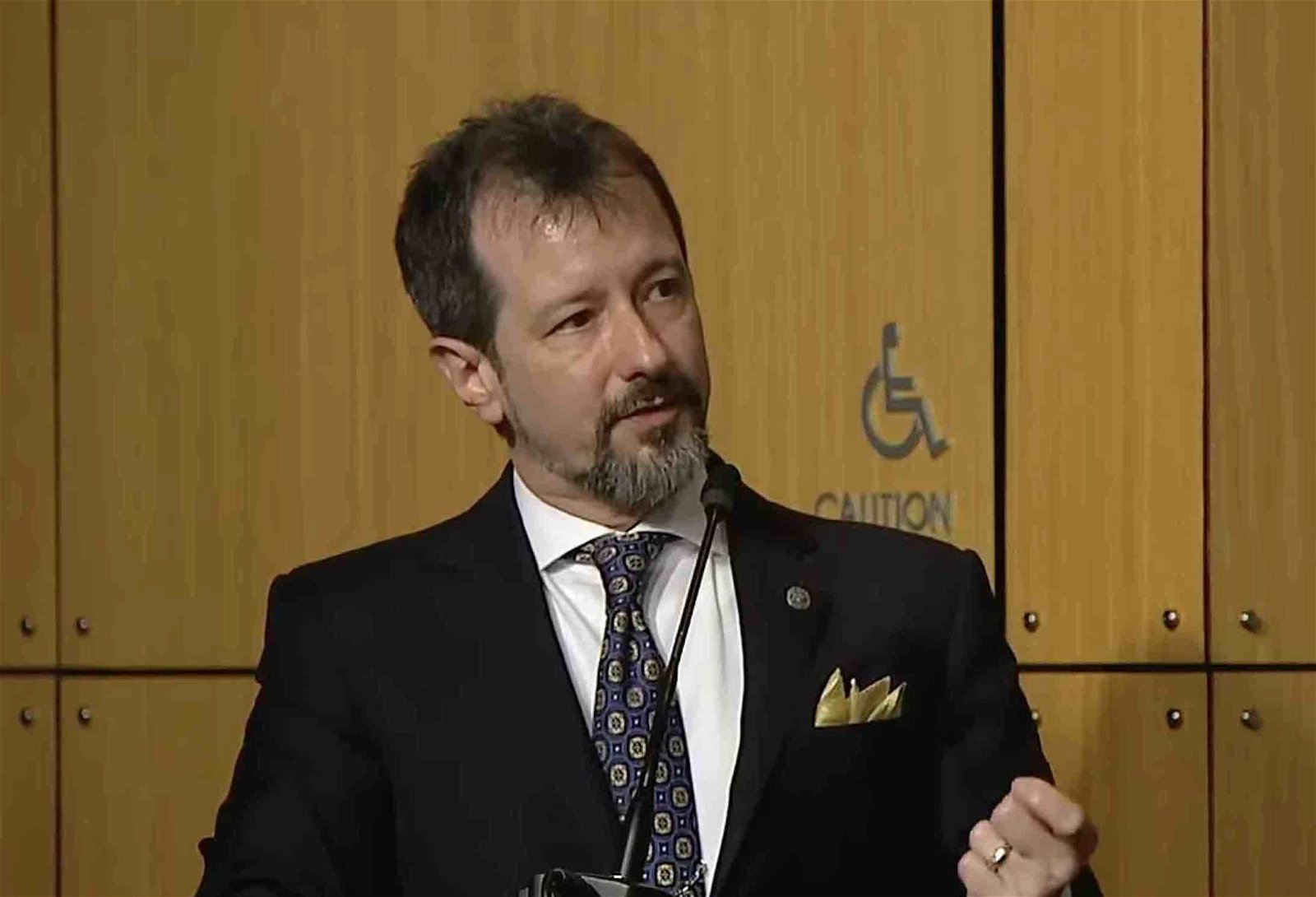

Welcome to this week’s installment of The Intelligence Brief… on Tuesday, the Pentagon announced that it had finally instituted a secure reporting mechanism for U.S. government personnel to use to report to the All-domain Anomaly Resolution Office (AARO), which is tasked with the Pentagon’s investigations into Unidentified Anomalous Phenomena (UAP). However, right out of the gate, we’re seeing some concerning indicators… in our analysis this week, we’ll be taking a look at 1) the new secure portal and what it’s designed to do, 2) the glaring issues that already exist with the new reporting mechanism, and 3) why the mechanism seems doomed to fail in its objectives… and also why AARO leadership appears to be aware of all this from the outset.
Quote of the Week
“The apple cannot be stuck back on the Tree of Knowledge; once we begin to see, we are doomed and challenged to seek the strength to see more, not less.”
– Dr. Martin Luther King, Jr.
Latest News: In recent coverage from The Debrief, new simulations reveal that gas giant planets can act as ‘agents of chaos,’ wreaking havoc on potentially habitable planets. Elsewhere, SETI researchers and artists are uniting to understand whether humans will be able to decipher alien messages. Also, spy satellite images are now unveiling hundreds of lost Roman forts. You can find all our recent stories at the end of this newsletter.
Podcasts: In podcasts from The Debrief, this week on The Debrief Weekly Report, hosts Stephanie Gerk and MJ Banias get into how solar glass could revolutionize the solar power game, examine the mystery of what lies beneath all that ice in Antarctica. Meanwhile, on The Micah Hanks Program, we suspend our disbelief as we tackle terrors in the neighborhood and space-time mysteries for our annual Halloween episode. You can subscribe to all of The Debrief’s podcasts, including audio editions of Rebelliously Curious, by heading over to our Podcasts Page.
Video News: In the latest installment of Rebelliously Curious, Chrissy Newton catches up with Daniela de Paulis, an award-winning media artist and licensed radio operator currently serving as Artist in Residence at the SETI Institute and the Green Bank Observatory. Also, check out the latest episode of Ask Dr. Chance, where Dr. Glenn answers questions about time travel. You can get other great content from The Debrief on our official YouTube Channel.
With all the housekeeping out of the way, it’s time we look at the latest efforts by the DoD’s All-domain Anomaly Resolution Office to get to the bottom of UAP… and why, based on what we’re seeing so far, we’re a little concerned.
AARO Gets a New Secure UAP Reporting Mechanism for UAP… Or Does It?
This week, the Department of Defense (DoD) announced that it had instituted a new secure reporting mechanism for U.S. military personnel reporting to the All-domain Anomaly Resolution Office (AARO), which is tasked with the Pentagon’s investigations into Unidentified Aerial Phenomena.
However, there’s a catch: the new secure system, which is now active on AARO’s official website, is not intended to be used to collect reports about actual UAP sightings. Instead, the secure reporting mechanism is intended only as a reporting channel for U.S. military personnel “with direct knowledge of U.S. Government programs or activities related to UAP dating back to 1945.”
“AARO is NOT currently accepting reports of UAP sightings/encounters from the general public,” the reporting page on AARO’s website states, although adding that “In the future, reporting eligibility will be expanded to the general public and include reports of any event related to UAP.”
Perhaps members of the public shouldn’t feel left out, since apparently members of the military still aren’t able to submit their reports through the new secure portal either, and have been advised to “Please follow the process established by your service branch or federal agency to report the information to AARO.”
So, AARO finally has a secure system for collecting information, but one that isn’t equipped to collect any actual reports of UAP. Nonetheless, the fact that any secure reporting system is now in operation may seem like a promising indicator of progress on behalf of the Pentagon’s official UAP investigative unit… but not so fast: a closer look at the fine print still gives us good reason to be more than a bit concerned.
The Secret UAP Program Reporting Mechanism That Wasn’t
Since June of this year, revelations involving claims of secret U.S. government programs involved in retrieving exotic craft or technologies have dominated the UAP discussion. The claims, while still unconfirmed, have received widespread media attention since The Debrief first broke the story of whistleblower David Grusch on June 5 in an article by reporters Leslie Kean and Ralph Blumenthal.
The resulting media attention ultimately led to a Congressional hearing in July, where Grusch, along with former U.S. Navy pilots David Fravor and Ryan Graves, restated many of their past claims and made additional statements, all while under oath. Given the level of attention such claims have received in recent months, one would be inclined to think that AARO, the DoD’s official UAP investigative office, would also be eager to learn whether there was indeed any fire behind all this smoke.
Hence, the secure reporting mechanism makes sense in principle, given that there are already established channels that U.S. military personnel may use to report their UAP sightings. AARO wants to ensure that, for now, those who might be able to offer information that corroborates the claims of those like David Grusch have a secure means of getting that information directly to its investigators.


That process, unfortunately, will inevitably be hampered by the very conditions outlined on the secure reporting mechanism’s page on the AARO website.
“Please do NOT submit any information that is potentially CLASSIFIED, or unclassified information that is not publicly releasable (e.g., subject to export control regulations),” reads a section of bold underlined print near the top of the site’s reporting form. So, in other words, if there was any expectation that a secret—and therefore what is likely to be a classified—U.S. government program related to UAP might exist, AARO is effectively advising U.S. personnel with such knowledge not to report it.
One has to wonder what the purpose of creating the secure reporting mechanism would be at all, especially if AARO isn’t accepting any classified information or details that otherwise aren’t already “publicly releasable.” Logic would seem to dictate that if such programs had ever existed and involved information that was deemed to be publicly releasable, then we probably would have already known about them by now.
Equally sad is the fact that AARO’s director, Dr. Sean Kirkpatrick, seems to be acutely aware of all of these issues.
AARO Holds an Off-Camera Press Gaggle… and Confirms Our Concerns
On Tuesday evening, the DoD held an off-camera media roundtable with Dr. Sean Kirkpatrick, Director of the All-Domain Anomaly Resolution Office. Also in attendance was Defense Press Operations Spokesperson Susan Gough. At one point during the roundtable, Dr. Kirkpatrick was asked whether he was confident that AARO’s current staffing levels could handle large influxes of reports as his Office institutes reporting mechanisms, first for U.S. government personnel, and eventually for fielding UAP reports from the public.
Kirkpatrick, after acknowledging that he has “surge capability” if large numbers of reports were to begin to be received, added the following revealing tidbit: “[I]f I look at this through the lens of if we start with the hypothesis that there is a highly protected program somewhere that very few people have access to, then I would expect very few people would be able to come and report that [author’s emphasis]. Because there… just aren’t that many people that would then, in theory, be briefed to that.”


One has to assume that such secretive UAP programs would, in likelihood, be classified Special Access Programs (SAPs) if they existed. Kirkpatrick’s own reference to the small number of people he expects would “be briefed to that” seems to acknowledge this likelihood. Hence, the AARO Director’s own expectation seems to be that people qualified to speak about secret U.S. government UAP programs will not be able to convey this information to AARO, given its own strict rules involving the communication of classified information.
Again, we are left to ask why AARO would go to the trouble of instituting a secure system for collecting information from U.S. government personnel about what is likely to be one of the greatest secrets ever kept, while excluding classified information from what it can collect. Frankly, none of this makes any sense.
Altogether, it seems relatively pointless for AARO to have launched a new secure reporting mechanism if it is already so inherently limited in terms of what information it can gather. Given such circumstances, not only can Kirkpatrick and his office “expect very few people” to report on the kinds of programs AARO is purportedly looking for… but they can almost be assured that they won’t get any information at all until they can offer a better means for U.S. government personnel to provide that information.
That concludes this week’s installment of The Intelligence Brief. You can read past editions of The Intelligence Brief at our website, or if you found this installment online, don’t forget to subscribe and get future email editions from us here. Also, if you have a tip or other information you’d like to send along directly to me, you can email me at micah [@] thedebrief [dot] org, or Tweet at me @MicahHanks.


Here are the top stories we’re covering right now…
- Decoding the Cosmos: ‘A Sign in Space’ Reveals the Art of Interstellar Communication
SETI researchers, space scientists, and artists unite to collaborate on the convergence of SETI and art with “A Sign in Space.”
- These Deep Space ‘Agents of Chaos’ Likely ‘Wreak Havoc’ on Alien Lifeforms
New simulations by California astrophysicists reveal that gas giant planets can act as ‘agents of chaos’ by wreaking havoc on the orbits of earthlike planets capable of supporting alien lifeforms.
- Hundreds of Lost Roman Forts Revealed By Spy Satellite Imagery, Challenging History’s View on Ancient Frontiers
Spy satellite images unveil over 300 lost Roman forts, reshaping views on ancient Roman frontiers and trade.
- Pentagon Launches Secure Reporting Mechanism for U.S. Personnel with Knowledge of Government UAP Programs
The Pentagon’s All-domain Anomaly Resolution Office (AARO) has just launched a secure portal for receiving information from U.S. personnel.
- What Lies Beneath All That Antarctic Ice? This week on The Debrief Weekly Report…
On today’s episode, we get into how solar glass could revolutionize the solar power game, examine the mystery of what lies beneath all that ice in Antarctica.
- Creepy ‘Face’ Captured on the Surface of Jupiter by NASA’s Juno Spacecraft
Just in time for Halloween, NASA’s Juno spacecraft has returned an image of cloud formations on the surface of Jupiter that seems to resemble a creepy face.
- Engineers Have Turned This Killer Greenhouse Gas into An Efficient Fuel Source
Engineers from MIT and Harvard University have unveiled an innovative process to transform carbon dioxide into formate, a substance that can function as a stable fuel.
- Ancient ‘Feat of Engineering’ Nearly 1,000 Years Older Than the Pyramids Found on Remote North Sea Island
Archaeologists say they have unearthed an ancient ‘feat of engineering’ on a remote island that had nearly been lost to history.
- U.S. Reveals Plans to Build New State-of-the-Art Nuclear Gravity Bomb
The U.S. is planning to develop a modernized variant of the B61 nuclear gravity bomb, the Department of Defense (DoD) has revealed.
- NASA’s Mysterious X-59 Supersonic Experimental Aircraft is Finally Gearing Up For Its First Flight
NASA’s mysterious X-59 experimental aircraft is moving towards its first flight following an announced goal of 2024.
- SpaceX Falcon 9 Launch of Starlink Satellites Delayed After Liftoff from Cape Canaveral is Postponed
SpaceX postponed the launch of its next delivery of Starlink satellites into orbit Sunday evening, according to an online posting by the American space technology and launch systems provider.
- Your Friends Probably Have More Friends Than You Do: Using Math to Explore the “Friendship Paradox”
According to a mathematical theory recently explored by a team of researchers, your friends are likely to have more friends than you do.
- Unexpected Discovery Hidden Underneath Antarctic Ice Shelf for Millennia Found by Space Robot
Researchers studying beneath the Antarctic Ice Shelf say they have discovered stunning patterns and features no one has seen before.
- Odd Formations on Mars Are Not Ordinary Strata After All, But Likely Clues to Ancient Habitat
Unique formations on Mars previously dismissed as ordinary rock strata may actually be signs of an ancient habitat on the red planet.
- Has the Mystery Behind One of the U.S. Military’s UAP Videos Been Solved?
This week, a U.S. government video that reportedly depicts an anomalous aerial vehicle revealed earlier this year could now have an explanation.
- Solar Panels Beware: Solar Glass is Here.
In an era where renewable energy is quickly becoming a necessity, innovations such as solar glass are emerging to harness nature’s resources efficiently.
- A 5,000-Year-Old Egyptian Tomb is Revealing its Secrets, and What Was Found Inside Could Rewrite Ancient History
A team of archaeologists studying a 5,000-year-old Egyptian tomb say their unexpected findings may dramatically alter previously held beliefs about the country’s ancient history.
- AI Systems Like ChatGPT Have a ‘Dark’ Side, and Researchers are Sounding the Alarm on Their Cyberattack Potential
New research into potential risks in Text-to-SQL AI models is revealing cybersecurity concerns with AI systems like ChatGPT.
- 2000-Year-Old Substance Unearthed at Ancient Roman Sites Possesses “Extraordinary” Properties
Scientists have unearthed something remarkable at several ancient Roman archaeological and construction sites, revealing artifacts coated in a naturally formed substance with unique modern technological potential.
- Earth to Receive Enigmatic Alien Transmission from Mars: Can We Decode the Message?
Chrissy is joined by Daniela de Paulis, an award-winning media artist and licensed radio operator who currently serves as Artist in Residence at the SETI Institute and the Green Bank Observatory.
- The 2023 Annual UAP Report: An Analysis
This week on The Micah Hanks Program, we provide an in-depth analysis of the 2023 UAP report and highlight the key takeaways many missed.
